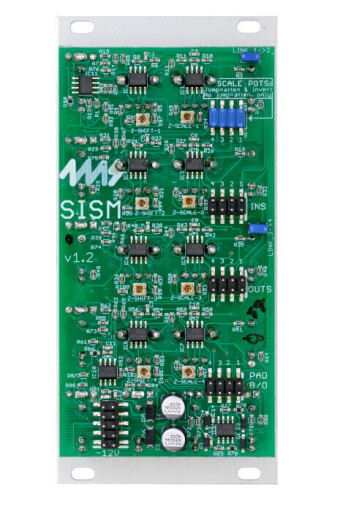4MS Shifting Inverting Signal Mingler



 663 BYN предложить свою цену
45637
663 BYN предложить свою цену
45637
Купить сейчас
Добавить в корзину
Уведомить о снижении цены
Уведомить о поступлении товара
Super practical four-channel voltage manipulator for scaling, attenuating, inverting and mixing signals. Offset can be generated by the SISM as well and the slice function extracts the sums of all positive or negative voltages. Plenty of LEDs show what's going on with your signal.
Each of the four channels has both an input and output socket. The bi-polar scale potentiometer (a so-called polarizer or attenuverter) is used for scaling, attenuating or inverting the signal. In it's default state it ranges from inverted unity gain over zero to unity gain. Alternatively you can use jumpers for changing the range: either uni-polar (0 to unity gain) or boost (0 to 2x unity).
The shift control adds an offset voltage from -9V to +9V to the signal. Red and blue LEDs visualize polarity and intensity of the signal.
The inputs of channels 1+2 and 3+4 are normalized which is good for splitting and individual processing of signals or for creating submixes using the slice function (see below). The normalizing can be deactivated with jumpers.
The four sockets at the bottom provide different signal mixes: "+ slice " and "- slice" give you the mix of all positive or all negative voltages. "mix sw" (sw = switch) mixes only channels where no cable is inserted into the output socket. "Mix" is the direct sum of all four channels. Once again red and blue LEDs inform you about polarity and level of the signals at the different outputs.
The module has several internal conenctors for other 4ms modules:
input: 2x4 pin header for connecting the output of a QCD or QPLFO to the SISM's inputs. Plugging into the input jacks overrides the signal on the header
output: 2x4 pin header for connecting to the input of a VCA Matrix or other compatible module
PAD breakout header (2x4) for connecting to a breakout module that applies a pre-set pad (attenuation) to each channel.
Заводская спецификация и комплектация с сайта производителя
Each of the four channels has both an input and output socket. The bi-polar scale potentiometer (a so-called polarizer or attenuverter) is used for scaling, attenuating or inverting the signal. In it's default state it ranges from inverted unity gain over zero to unity gain. Alternatively you can use jumpers for changing the range: either uni-polar (0 to unity gain) or boost (0 to 2x unity).
The shift control adds an offset voltage from -9V to +9V to the signal. Red and blue LEDs visualize polarity and intensity of the signal.
The inputs of channels 1+2 and 3+4 are normalized which is good for splitting and individual processing of signals or for creating submixes using the slice function (see below). The normalizing can be deactivated with jumpers.
The four sockets at the bottom provide different signal mixes: "+ slice " and "- slice" give you the mix of all positive or all negative voltages. "mix sw" (sw = switch) mixes only channels where no cable is inserted into the output socket. "Mix" is the direct sum of all four channels. Once again red and blue LEDs inform you about polarity and level of the signals at the different outputs.
The module has several internal conenctors for other 4ms modules:
input: 2x4 pin header for connecting the output of a QCD or QPLFO to the SISM's inputs. Plugging into the input jacks overrides the signal on the header
output: 2x4 pin header for connecting to the input of a VCA Matrix or other compatible module
PAD breakout header (2x4) for connecting to a breakout module that applies a pre-set pad (attenuation) to each channel.
характеристики
Скачать мануал 4MS Shifting Inverting Signal Mingler
